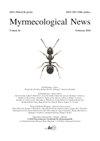Induced immune responses in Formica fusca (Hymenoptera: Formicidae)
IF 3.8
1区 农林科学
Q1 ENTOMOLOGY
引用次数: 6
Abstract
Parental immune experience can enhance offspring defence mechanisms towards prevalent pathogens in the surrounding environment. This process of inherited resistance from one generation to another is known as trans-generational immune priming (TGIP) in invertebrates. In sedentary and dense insect societies, such as ant colonies, TGIP can influence colony survival and fitness upon pathogen outbreaks. However, TGIP appears to depend on species and environmental stressors and therefore can vary in intensity, as well as in the molecular mechanisms leading to resistance. Here, we stimulated the immune system of queens of the ant Formica fusca (Linnaeus, 1758) by wounding or injecting dead conidia of the entomopathogenic fungus Beauveria bassiana (Bals.-Criv.) Vuill. (1912). The offspring were subsequently infected with B. bassiana , and the effect of this priming on survival was evaluated. Furthermore, we investigated whether immune challenge of the mother queen induces changes in the expression of immunity-related genes in queens themselves and their brood. We combined this information with measurements of offspring size and number. Larvae produced by untreated queens had a significantly higher mortality after infection with B. bassiana , whereas those produced by immune-primed queens survived no worse than unexposed ones. Adult worker offspring from sham-control mothers showed a protective effect of queen treatment, consistent with transgenerational immune priming. Thus, the effects of queen priming appear to manifest themselves slightly differently in larval and adult offspring. No differences were detected in offspring number or size, but immune gene expression levels showed changes, both in queens and their offspring. Open access, licensed under CC BY 4.0. © 2018 The Author(s). Pages: 53-66 DOI: 10.25849/myrmecol.news_028:053 Volume: 28 Year: 2018 Journal: Myrmecol. New富蜂的诱导免疫应答(膜翅目:富蜂科)
亲代免疫经验可以增强后代对周围环境中流行病原体的防御机制。在无脊椎动物中,这种从一代遗传到另一代的抗性过程被称为跨代免疫启动(TGIP)。在定居和密集的昆虫社会中,如蚁群,TGIP可以在病原体爆发时影响群体的生存和适应性。然而,TGIP似乎依赖于物种和环境应激源,因此可能在强度以及导致抗性的分子机制上有所不同。本研究通过损伤或注射球孢白僵菌(Beauveria bassiana, Bals.-Criv.)的死孢子来刺激fusca蚁(Linnaeus, 1758)蚁后的免疫系统。Vuill。(1912)。后代随后感染球孢白僵菌,并评估了这种启动对存活的影响。此外,我们还研究了母蜂王的免疫攻击是否会引起蜂王自身及其后代免疫相关基因表达的变化。我们将这些信息与后代的大小和数量相结合。未经处理的蜂后产生的幼虫在感染球孢白僵菌后死亡率明显较高,而免疫启动的蜂后产生的幼虫存活率并不比未暴露的蜂后差。来自假控制母亲的成年工蜂后代显示出女王处理的保护作用,与跨代免疫启动一致。因此,蜂后启动对幼虫和成年后代的影响似乎略有不同。在后代数量和大小上没有发现差异,但免疫基因表达水平在蚁后和它们的后代中都有变化。开放获取,CC BY 4.0许可。©2018作者。Pages: 53-66 DOI: 10.25849/myrmecol。news_28:053 Volume: 28 Year: 2018 Journal: Myrmecol。新
本文章由计算机程序翻译,如有差异,请以英文原文为准。
求助全文
约1分钟内获得全文
求助全文
来源期刊

Myrmecological News
ENTOMOLOGY-
CiteScore
7.30
自引率
4.90%
发文量
0
审稿时长
>12 weeks
期刊介绍:
Taxonomic manuscripts with isolated species descriptions are generally discouraged, especially for genera with large numbers of undescribed species; it lies at the discretion of the editorial team whether such manuscripts are considered. Papers on new distribution records will be considered if the new records are sufficiently important or unexpected from a biogeographical perspective. Such papers could, for example, discuss relevant biological/ecological data and/or biogeographical implications such as analysis by species-distribution modelling.
In detail, research areas covered by Myrmecological News include: behaviour; biogeography and faunistics; biological-pest control; chemical ecology; climate-change biology; cognition and learning; comparative and functional morphology; community ecology; conservation biology and bioindication; cytogenetics; ecology and evolution of (endo)symbioses; ecosystem (dis)services; foraging strategies; fossils; fragmentation ecology; genomics; histology; immune research; (integrative) taxonomy; interspecific hybridisation; invasion biology; life-history research; methodology in community quantification; national checklists; neurobiology; niche ecology; orientation and navigation; phenology; phylogeny and phylogeography; population genetics; sensory physiology; social evolution; social parasitism; sociogenomics; stable isotopes; tools for routine identification.
 求助内容:
求助内容: 应助结果提醒方式:
应助结果提醒方式:


